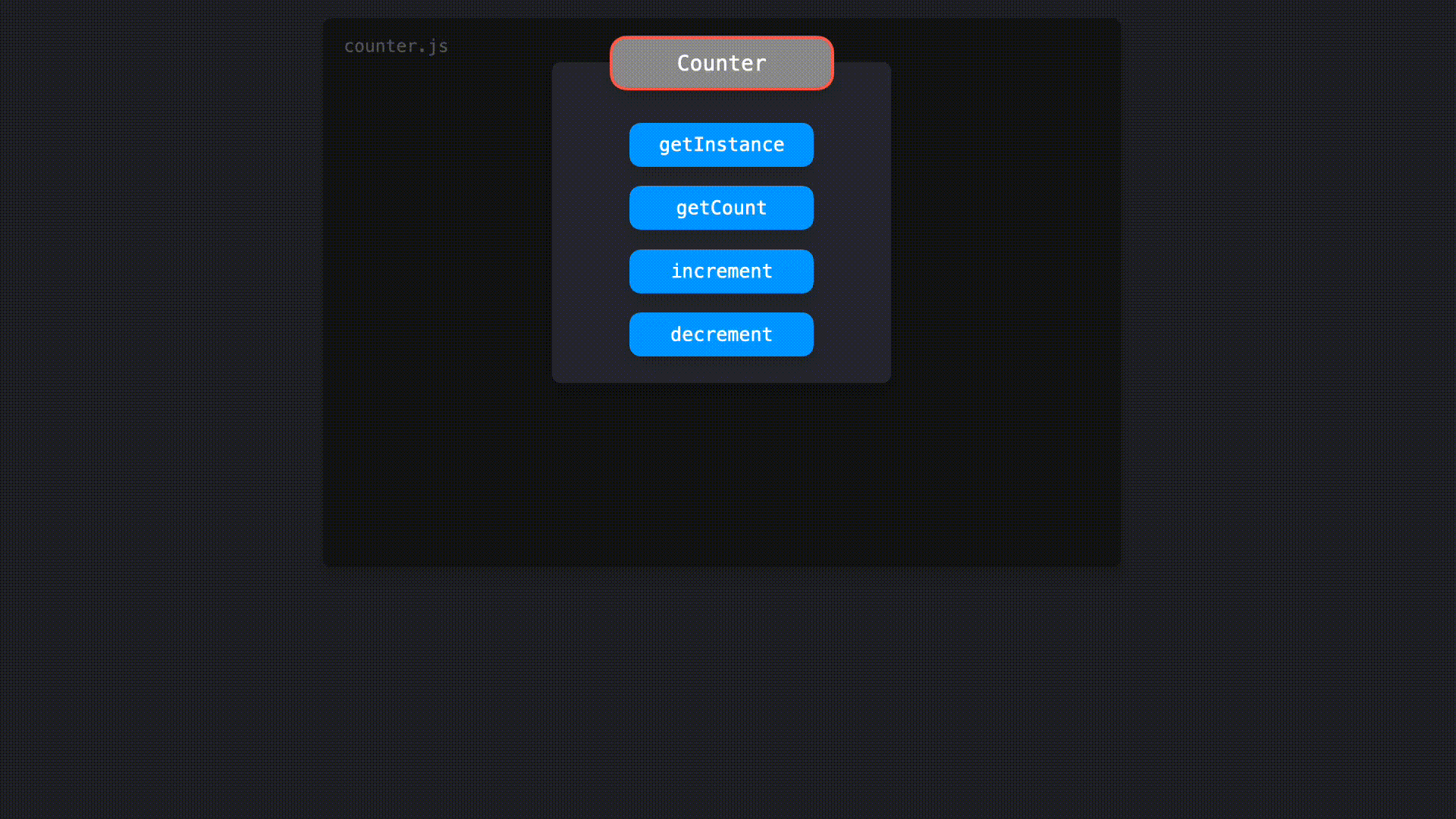Share a single global instance throughout your application.
Singletons are classes which can be instantiated once, and can be accessed globally.
which makes Singletons great for managing global state in an application.
For this example, we’re going to build a Counterclass that has:
- a
getInstancemethod that returns the value of the instance. - a
getCountmethod that returns the current value of thecountervariable. - an
incrementmethod that increments the value ofcounterby one. - a
decrementmethod that decrements the value ofcounterby one
let counter = 0;
class Counter {
getInstance() {
return this;
}
getCount() {
return counter;
}
increment() {
return ++counter;
}
decrement() {
return --counter;
}
}However, this class doesn’t meet the criteria for a Singleton! A Singleton should only be able to get instantiated once.
Currently, we can create multiple instances of the Counterclass.
const counter1 = new Counter();
const counter2 = new Counter();
console.log(counter1.getInstance() === counter2.getInstance()); // falseBy calling the new method twice, we just set counter1 and counter2 equal to different instances.
The values returned by the getInstanc method on counter1 and counter2 effectively returned references to different instances: they aren't strictly equal!
 Let’s make sure that only one instance of the
Let’s make sure that only one instance of the Counter class can be created.
Let’s make sure that only one instance of the Counter class can be created.
One way to make sure that only one instance can be created, is by creating a variable called instance .
In the constructor of Counter, we can set instance equal to a reference to the instance when a new instance is created.
We can prevent new instantiations by checking if the instance variable already had a value.
If that's the case, an instance already exists.
This shouldn't happen: an error should get thrown to let the user know.
let instance;
let counter = 0;
class Counter {
constructor() {
if (instance) {
throw new Error("You can only create one instance!");
}
instance = this;
}
getInstance() {
return this;
}
getCount() {
return counter;
}
increment() {
return ++counter;
}
decrement() {
return --counter;
}
}
const counter1 = new Counter();
const counter2 = new Counter();
// Error: You can only create one instance!we should freeze the instance as well.
The Object.freeze method makes sure that consuming code cannot modify the Singleton. Properties on the frozen instance cannot be added or modified, which reduces the risk of accidentally overwriting the values on the Singleton.
Let's export the Counter instance from the counter.js file.
let instance;
let counter = 0;
class Counter {
constructor() {
if (instance) {
throw new Error("You can only create one instance!");
}
instance = this;
}
getInstance() {
return this;
}
getCount() {
return counter;
}
increment() {
return ++counter;
}
decrement() {
return --counter;
}
}
const singletonCounter = Object.freeze(new Counter());
export default singletonCounter;Let's take a look at an application that implements the Counterexample. We have the following files:
counter.js: contains theCounterclass, and exports aCounterinstance as its default export.index.js: loads theredButton.jsandblueButton.jsmodules.redButton.js: importsCounter, and addsCounter'sincrementmethod as an event listener to the red button, and logs the current value ofcounterby invoking thegetCountmethod.blueButton.js: importsCounter, and addsCounter'sincrementmethod as an event listener to the blue button, and logs the current value ofcounterby invoking thegetCountmethod
When we invoke the increment method in either redButton.js or blueButton.js , the value of the counter property on the Counter instance updates in both files.
It doesn't matter whether we click on the red or blue button: the same value is shared among all instances.
This is why the counter keeps incrementing by one, even though we're invoking the method in different files.

